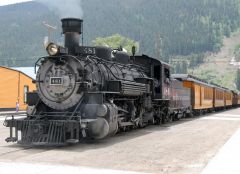-
Content Count
60 -
Joined
-
Last visited
-
Days Won
1
Profile Information
-
Gender
Male
-
I travel
With Pets
Recent Profile Visitors
5046 profile views
-
Cruzer started following AGM or Wet Cell, Cold Weather Driving, Refrigerator Door Locks and and 3 others
-
We had an ISL400 on our 2004 Bus and now the same engine in our 2007 Bus. The difference was the chassis. Maybe something similar would apply to your situation. After all, it sounds like you have all of your components in good shape. The radiator was replaced, the fan blows your hat off, and the engine (therefore the water pump) is quite new. Plus, your last engine ran hot too. Our '04 Bus was on a Freightliner chassis. Tiffin, as well as others, had issues during that era once the hotter burning EPA-2004 spec engines came out. Freightliner used a 1,050 sq in radiator. Then they stacked the charge air cooler right behind it as well as the hydraulic oil cooler. This meant that the radiator never got cool air, only preheated air. When climbing mountain grades out west the engine would overheat regularly. The 400ISL had plenty of torque but I was relegated to manually downshifting prior to starting those grades so that the engine's water pump would spin faster and the intake airflow was also increased. This helped prevent the temperature from climbing too far. Freightliner had a series of recalls that I went through but they were all shots in the dark that didn't correct the root of the problem, which was the too-small cooling system. The system wasn't redesigned until the new EPA-2007 emissions came out with the diesel Particulate Filters. Their recalls revolved around wrapping reflective tape around the air intake hose, adding a bunch of dampers to redirect the radiator airflow, replacing the Dexron hydraulic oil with 15W-40 engine oil to keep the hydraulic fan speed higher, and eventually a new oil cooler because the heavier 15W-40 oil ruptured the existing coolers, which were never designed for the thicker oil. All I could do was anticipate and downshift. Our '07 Bus is the same engine but on a Spartan chassis and a heavier tag axle coach. Spartan's cooling system uses a 1,326 sq in radiator, a charge air cooler that is stacked vertically above the radiator and an oil cooler also stacked so that everything gets a shot of clean air. This coach never breaks a sweat in any circumstance and I've climbed some steep stuff at high altitudes, drive in 106 degree heat, etc. My point is that your cooling system may not be large enough. I don't know how your system is designed (size of radiator, stacked versus inline, etc) but it's possible you may have some design issues that can't be easily corrected. If not, I would look at airflow because you seem to have everything else taken care of. Not having radiator shroud that is effectively matched to the fan makes a huge difference on being able to get the air flow through the radiator. Also, making a way for the hot air to exit the engine compartment is also critical. You may need to add some vents or screens. If you think that may be the case, remove one or both of your engine bay doors and go for a test drive. If it no longer gets hot, your air outflow might be the problem. Otherwise - downshift often - LOL.
-
We have similar coaches. The front axle is actually a 14,600 lb rated axle, however, with the 275/80R22.5 LRH Michelins you are limited to 14,320 lbs.According to Spartan, you should have one third of the weight on the tag axle and 2/3 on the drive axle so you proportioning valve is set properly. The real issue is that Tiffin put too much weight on the front axle. It took them a few years to figure out how to deal with that as the tag axle Bus was new in 2006. Now your decision is how to deal with that. A number of owners had their tires upgraded to 295s, which increased the load capacity. Technically the tires were now better than the axle rating but later on the axles were rerated at 15,600 with only a wheel bearing and spindle change, which really wasn't necessary in an occasional vocation situation like a motorhome. One thing to consider is that the Allegro Bus on a Freightliner came with 8.25" wide rims while the Spartan came with the 7.5" wide rims, which are perfect for the 275 tires but too narrow for the 295s. So if you get larger tires you'll need to replace the two front wheel rims as well. Some owners have played games with the rear proportioning valve. That's a band-aid fix that does serve to lessen the load on the tag axle and shift more to the driver axle. The tag axles is designed to carry lots of weight, which is good, but the downside is that it acts as a lever, pivoting that weight on the rear axle and shifting it to the front (steer) axle. That's why all of the tag axle Tiffins had front weight issues while the 40' single rear axle coaches tended to have overweight issues on the rear axle with light front end weights. If you reduce the tag axle bag pressure by shifting the proportioning valve you will reduce the front axle weight but there's only so much you can go without changing the overall geometry and stability that the chassis was designed for. It's a tough spot to be in. Our 42QRP "just" makes it on the front axle. Many of the later coaches got worse as they added more Corian, ceramic tile, and other heavy "stuff" to the coaches. That's why Entegra now has a 16K front axle and 315 tires.
-
First of all, your house battery bank and chassis battery bank are two separate items. You don't have to go all AGM or all flooded. I have a mix of AGM house batteries and flooded chassis batteries in our coach and am a big fan of AGMs. Your inverter-charger will be set for ther house batteries, which is what take the charge. Your chassis batteries aren't handled by the inverter-charger unless you have a Trick-L-Start or BatteryMinder installed. Either way, those small charges won't negatively impact your flooded chassis batteries if you have AGM house batteries. AGM batteries have a number of benefits over flooded. The downside is that they cost more so it's always a decision as to whether yopur particular usage justifies the extra expense. In the case of engine starting batteries, that's pretty hard to justify. But in the house section, that's another story. As previously mentioned, AGMs charge faster due to less internal resistance. That can be a benefit in certain situations. They don't outgas like flooded batteries do so the terminals and connections don't get the corrosion that you get from the sulfuric acid vapors present in flooded batteries nor do they have the venting requirements of flooded batteries because their hydrogen output is minuscule at best. That gives you a wider choice of where to locate them. Batteries also have a recommendation to never discharge below 50% or else it takes a toll on their longevity. In reality, it's not the 50% that's the cutoff point. It's the voltage drop at 11.8 volts. On a flooded battery this happens to come in around the 50% mark, which is why that figure is often mentioned. But an AGM has a flatter curve when comparing its discharge on a voltage versus amp-hrs used graph. An AGM battery will run a bit longer, allowing you to use as much as 30% more amp-hrs from the batteries until you get to that 11.8 volts. That really gives you 30% more amp-hrs, which is like getting a free battery on a four battery system. As to longevity, that will vary according to quality. I suggest getting good batteries, rather than price if you want to go with AGMs. The Lifeline batteries are the best. They will give you the 220 AH that your flooded batteries have (keep in mind that you can only use about 110 AH from your flooded but more like 140 on the AGMs) and are designed to last longer than flooded batteries, although that always depends on the way they are treated. Your Magnum inverter recognizes the difference between Lifeline and the other brands and will have settings available that let you choose the Lifeline AGM batteries or other AGM batteries as well as flooded batteries. I believe the choices are AGM-1, AGM-2 and Flooded. I don't recall which AGM is for the Concord Lifelines but your Magnum manual will show you. Can you justify the upcharge for AGMs? That depends. I have eight of them in our coach and generally don't boondock but when I do they give me plenty of power to run the residential fridge and other stuff, especially on a cold night when the Aquahot's diesel burner is running non-stop. I don't have any corrosion issues on my cables either. But eight of them do make a dent on the checkbook. My brother-in-law had two 6 volt batteries in their coach and they needed replacement. He considered AGMs but they are plugged into campsite power 99% of the time (fulltimers) and he didn't have that bad of a corrosion issue. Corrosion comes from outgassing, which comes when the battery is charged with excessive voltage, most notably on the float cycle. If your inverter-charger is doing its job you shouldn't have issues with having to add water all the time or cleaning terminals. So in his case we opted to just buy a pair of flooded batteries.
-
I've upgraded three times. Can't make up my mind, I guess. Originally I had the Winegard batwing. I rarely used off-air TV so it wasn't a big deal. Eventually I replaced it with a Winegard RS2000. The RS2000 is an omnidirectional antenna so I never have to aim it. It's just a saucer shaped disk that sits on the rear deck of my motorhome and I never have to wonder whether it's up or down because it just sits there. It worked well for my needs because I rarely use it and it's foolproof. However, when in fringe areas it doesn't have the power that the batwing did. So I went back to the front of the coach and installed the King Jack, based upon favorable comments from others. The King Jack does need to be aimed but you don't have to raise or lower it so it's a no-brainer for transit and can't get damaged because you forgot to put it down. I found that the King Jack got about the same reception as my former batwing. However, I've never tries the batwing with the Wingman addition to it so my "guess" is that the wingman setup would have more range in fringe areas. But then I have to deal with the up and down aspect and I rarely need off-air in fringe areas that bad so it works for me. If you rely on off-air and aren't always close to major stations, the Sensar with Wingman would probably be your best choice.
-
My favorite was the system that I saw during my road test for FMC Magazine of the Newmar Mountain Aire. They had a sliding mechanism that locked both of the upper doors with the slide-out freezer bin on the bottom. Simple to use, very effective and foolproof. Don't know if the latch was proprietary or if Newmar bought them from a vendor though.
-
We did it all the time in our past motorhomes, which had LP furnaces. This is Wisconsin, where winter is long, and without heat we would be popsickles. In our current MH we have AquaHot, so it's diesel powered but that runs too. I don't see the safety aspect of switching off the propane when driving. It would take a pretty wild sequence of events that would cause an issue during a crash. It's safer to be warm and comfortable when driving than shivering and trying to deal with frosty windows.
-
The EMS 800 requires a 12 volt DC hot lead and a good ground to power the control board. If the ground is intermittent or your hot feed is iffy the EMS will shut down and the AC relays will stay in the open position, rendering those circuits dead. The only way to close those relays so that AC power can flow through is by applying 12 volts to the board. Load shedding problems generally are a board issue but in your case I would first check the DC supply and ground for any loose connections. Also, there is a small fuse on the board that may be in intermittent mode. It could even be in a dirty socket so pulling it out and reseating it may do the trick.
-
Actually, you can synchronize two generators. I learned that when I took the factory certified service tech school at Kohler's generator plant. They need to be fed through a load matching transformer and each one will lock onto the waveform in the transformer so that they sync up. You wind up with two input windings and one common output winding. It's a load matching transforner, not a step up or step down. The problem is that these aren't on your average electrical supply house shelf and they will be pricey. They do it all the time in large applications but it's pricey for 60KW and under. Frankly, I don't care for the split neutrals either. If it was me I'd just get a 120/240 split phase generator rather than a straight phase 120-only unit to run things.
-
We always keep it full. One time when our coach died and needed to be towed we had to follow in the Jeep. It was a long tow in the middle of nowhere and without a full tank of fuel we would have been in trouble. As to the fuel pump thing - it's true. Today's fuel pumps are electric submersibles that sit down in the bottom of the tank. They get hot and the fuel that surrounds them actually acts as a coolant for them. Now, they won't burn out the minute you go low on fuel but the heat doesn't do them any favors, either so it's more of an accumulative thing. People who constantly run their vehicle "on a challenge" with low fuel levels will have a greater incidence of fuel pump replacements than those who keep a fair amount of fuel in their tank on a regular basis. All pumps are different. Some are short and fat while some are tall and slender. A good average is that once you go below 1/4 tank the top of the pump will start to get exposed and you lose some cooling action.
-

Motorhome With Rear Axle vs Rear Axle With Tag Axle?
Cruzer replied to Fliphoppers's topic in Type A motorhomes
Most class A motorhomes up through 40' use a single rear axle. Generally, anything over 40' gets a tag axle, although there are always exceptions. A rear axle has weight limitations. Federal Bridge Law limits any single axle to 20,000 lbs. The rear axle weight of a fully loaded 40' coach gets very close, sometimes over, that amount. So, a larger, longer coach needs an additional axle to help carry the weight. Tag axles are generally rated at 10,000 lbs capacity so now the rear of the coach can safely carry 30,000 lbs and there are no more rear axle weight issues. Tag axles also help reduce the rear overhang of the coach. Shorter coaches can get pushed around by 18 wheeler bow wakes or strong winds because that area acts as a sail that causes the coach to pivot laterally at the rear axle, making steering corrections necessary. A tag axle greatly reduces that and you'll find that it's much more enjoyable to drive a coach with a tag axle. The downside is that the coach is longer and costs more but I've found that maneuverability really isn't a drawback and we can put our 42' tag axle coach most anywhere our 40' single axle coach went. Plus, it's a much more solid handling ride. -
I had two 110 watt panels on my last coach and now have four 125 watt panels on this coach. Each system had maybe 3/4" between the panel and the roof. However, the panel itself is recessed within the frame to allow for the electrical connection box so in reality the actual panel is probably 2" up from the roof while only the frame is 3/4". I've never had any issues with heat and find that most heat is reflected and on the top surface of the panel, not the bottom. I used fixed aluminum angle iron mounts designed for the panels. I used 3/16" stainless steel rivets to mount them to the roof rather than screws. I just don't have much faith in screws not pulling out and tearing the threads whereas the rivets knob up on the backside of the roof and hold very well. Be sure to apply self-leveling sealant beneath the mounting pads as well as all over the top of them to prevent any leaks.
-
How about http://www.rvcruzer.com/servicetips.php
-
It's sounds like your system is working fine but you just can't read any amps when on 50 amp shore power. If so, that's normal. Your Meridian uses an Intellitec EMS to shed loads when on 30 amp shore power. It samples the incoming voltage between L1 and L2. If it is zero it knows that you are not on 50 amps because a 50 amp split phase system would show 240 volts between L1 and L2. Next it tests for 12 volts at the generator run terminal. If it sees 12 volts it knows you are running on generator power so it displays the amperage but does no load shedding. If it does not see any 12 volts on the generator's B+ feed then it assumes you are on a 30 amp shore power feed and performs it's load shedding routines to keep the total draw beneath 30 amps. There is a current loop transformer on the neutral line that measures the amperage so that it can properly manage the load level. It will also display this current info on the LED display. If the EMS sees 240 volts between L1 and L2 it knows you are on 50 amp shore power so it does not perform any load shedding. However, it also cannot display any amperage because the current transformer is on the neutral wire. On a split phase system the neutral wire only carries the current differnce between L1 and Neutral and L2 and Neutral so it can't read what is really being used. Therefore the ammeter is blanked out during 50 amp operationb, although the small LED that indicates 50 amp power will be illuminated. In order to properly measure current draw on a 50 amp split phase feed there would have to be two transformers - one on L1 and one on L2. Prceision Circuits, Inc makes such a system and I recently replaced my Intellitec system with the PCI system. The PCI system even has the ability to interface with a Magnum inverter to add it's output in prior to making any load shedding decision. It's technology is much newer than the aged Intellitec system.
-
If you want the best, SmarTire is the way to go. I've had three systems so far between my previous coaches - TireSentry, Pressure Pro, and SmarTire. When it came time to set up the present coach SmarTire was my hands-down choice. However, it's also the most expensive. If you are trying to meter out tires that are already 8 years old you probably won't want to spring for the SmarTire system. The benefit is that it uses internal sensors that send both pressure and temperature information. It then calculates the proper pressure according to the current temperature. These temperature compensation algorithms track pressure differentials exactly. For details on this system check out my website tutorial at http://www.rvcruzer.com/smartire.php. I bought mine at Dickman Tires and highly recommend them. If your needs are more price sensitive I'd recommend TireSentry. That would be my choice in an external sensor system. You do have to remove the sensors to add air but they are no harder to remove than a valve stem cap and do not require recalibration. I've had good success with both systems. Regardless of your choice, I do recommend getting some sort of system. They won't protect against a severe instantaneous blowout but that's more due to running tires that are beyond their service life. Most tires fail from overheating after they have run with lower air pressure. If you pick up a nail you may never feel it but the tire will heat up and the sidewall will eventually blow if it gets hot enough for long enough. A TPMS system will tell you in advance and give you time to pull over and deal with it before it becomes catastrophic.





















